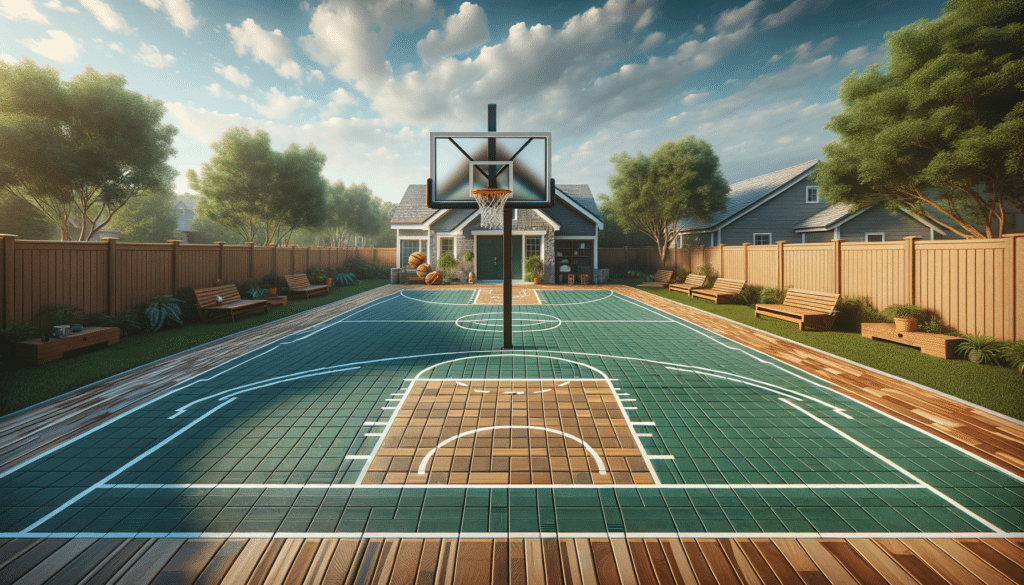The Rise of Backyard Basketball Courts
In recent years, backyard basketball courts have become increasingly popular among homeowners. This trend is not just about having a space to shoot hoops; it’s about creating a versatile and engaging outdoor environment for family and friends. A backyard basketball court offers a convenient way to stay active and enjoy the outdoors, making it an appealing addition for those who value both fitness and leisure.
Backyard courts can range from simple setups on driveways to more elaborate installations with professional-grade surfaces. The choice often depends on budget, available space, and the intended use of the court. For instance, a family with young children might prioritize safety and durability, while a serious player might focus on the performance characteristics of the surface.
Installing a basketball court in your backyard involves several considerations. It’s essential to evaluate the space available, ensuring there’s enough room not just for the court itself, but also for safe play areas around it. Additionally, local zoning laws and regulations may affect the size and placement of your court, so it’s crucial to check these before proceeding.
Exploring Outdoor Sports Flooring Options
When it comes to outdoor sports flooring, there are several options to consider, each with its own set of advantages. The right choice can significantly impact the playability, safety, and maintenance of your court. Common materials include concrete, asphalt, and synthetic surfaces, each offering distinct benefits.
Concrete is a popular choice due to its durability and low maintenance requirements. It’s a cost-effective option that provides a hard, flat surface, ideal for basketball. However, concrete can be unforgiving on joints, making it less suitable for players with joint concerns.
Asphalt is another option, offering a slightly softer surface compared to concrete. It’s often used in public courts and provides good traction for players. However, asphalt surfaces can degrade over time, especially if not properly maintained, leading to cracks and unevenness.
Synthetic surfaces offer a more forgiving play area, reducing the risk of injuries. These surfaces can mimic the feel of indoor courts while providing excellent weather resistance. They are available in various forms, such as interlocking tiles or poured surfaces, and can be customized in terms of color and design.
Benefits of Basketball Court Tiles
Basketball court tiles have emerged as a popular choice for many backyard installations. These tiles offer several advantages, making them a compelling option for those looking to create a high-quality playing surface. One of the primary benefits is their ease of installation. The interlocking design allows for quick assembly, often without the need for professional help.
These tiles are designed to provide excellent grip and shock absorption, enhancing player safety. This feature is particularly beneficial for reducing the impact on joints, making it suitable for players of all ages. Additionally, the tiles are weather-resistant, ensuring that the court remains in good condition regardless of the climate.
Maintenance is another area where basketball court tiles shine. Unlike concrete or asphalt, which can crack and require regular upkeep, tiles are easy to clean and replace. If a tile becomes damaged, it can be swapped out without affecting the rest of the court, making long-term maintenance more manageable.
Installation Considerations for Home Courts
Installing a backyard basketball court involves several key considerations to ensure the project is successful. First, it’s important to prepare the site properly. This includes leveling the ground and ensuring proper drainage to prevent water accumulation, which can damage the surface over time.
Choosing the right surface is crucial. While concrete and asphalt are traditional choices, many homeowners are now opting for synthetic surfaces or basketball court tiles due to their superior performance and ease of maintenance. The choice of surface will depend on factors such as budget, intended use, and personal preference.
Lighting is another important aspect to consider. Installing lights allows for play during the evening, extending the usability of your court. Solar-powered options can be a cost-effective and environmentally friendly choice for backyard installations.
Finally, safety should always be a priority. Ensuring that the court is free from obstacles and providing adequate padding around poles and walls can help prevent injuries. Additionally, considering the installation of a fence or netting can keep the ball within the play area, reducing the risk of damage to surrounding property.
Long-Term Maintenance and Care
Maintaining a backyard basketball court is crucial to ensure its longevity and performance. Regular cleaning is essential to prevent debris buildup, which can affect the playing surface and lead to premature wear. Using a leaf blower or a broom can help keep the court clean and free from dirt.
For surfaces like concrete and asphalt, regular inspections for cracks and other damage are important. Addressing these issues promptly can prevent more significant problems down the line. Sealing the surface periodically can also extend its lifespan by protecting it from the elements.
For synthetic surfaces and basketball court tiles, maintenance is generally more straightforward. Regular cleaning with water and a mild detergent can keep the surface looking new. It’s also important to check for any loose or damaged tiles and replace them as needed to maintain a safe playing environment.
Overall, investing time in maintaining your basketball court will ensure it remains a valuable addition to your home, providing enjoyment and fitness opportunities for years to come.


